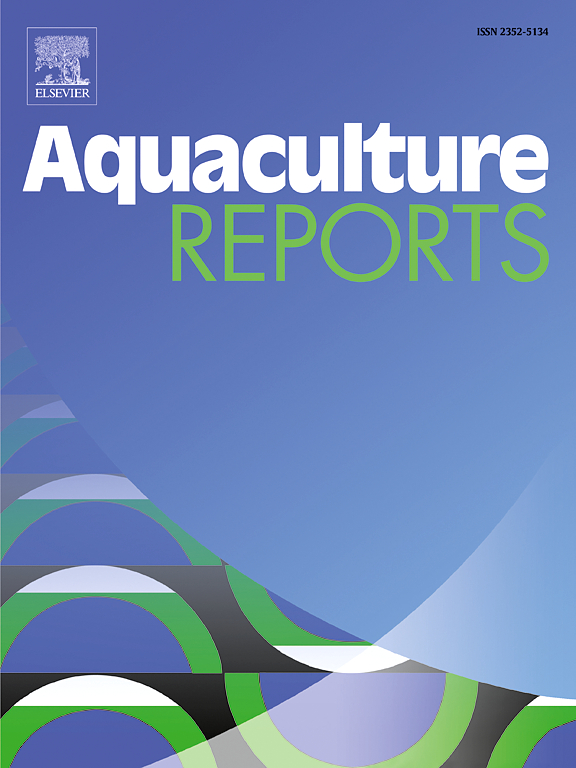酶法水解棉籽蛋白促进凡纳滨对虾食欲和肠道健康
IF 3.2
2区 农林科学
Q1 FISHERIES
引用次数: 0
摘要
本研究考察了酶解棉籽蛋白(ECP)对凡纳滨对虾食欲和肠道健康的影响(0.16 ± 0.01 g)。在对照饲料(鱼粉18 %、粗蛋白质40 %、粗脂肪7.5 %)的基础上,等量添加2 %、4 %、6 %、8 %和10 %的ECP替代鱼粉,分别配制成6种等氮等脂试验饲料,分别为ECP0 (control)、ECP2、ECP4、ECP6、ECP8和ECP10。饲喂8周后,血清促食欲素水平显著升高(P <; 0.05);饲粮中添加ECP显著降低了虾的瘦素、YY肽和胆囊收缩素及其基因表达量(P <; 0.05)。与ECP0组相比,ECP2组对虾增重率显著提高(P <; 0.05)。此外,ECP2组对虾肠折叠高度和肌肉厚度显著升高,质周膜因子基因表达量上调(P <; 0.05)。饲粮ECP2和ECP4显著提高了肠道淀粉酶、脂肪酶、胰蛋白酶和凝乳胰蛋白酶活性(P <; 0.05)。添加ECP显著降低了对虾肠道弧菌、光杆菌和tenacacbaculum的丰度,提高了Ruegeria和Marivita的丰度(P <; 0.05),特别是添加2 % ECP显著提高了对虾肠道菌群的膜转运和氨基酸代谢功能(P <; 0.05)。由此可见,以等量替代鱼粉添加2 ~ 4 % ECP可通过改善凡纳米对虾的食欲、肠道形态和肠道菌群组成来促进其生长。本文章由计算机程序翻译,如有差异,请以英文原文为准。
Enzymatic hydrolysis of cottonseed protein enhances appetite and intestinal health of Litopenaeus vannamei
This study examined the effects of enzymatic hydrolysis cottonseed protein (ECP) on the appetite and intestinal health of Litopenaeus vannamei (0.16 ± 0.01 g). Based on the control diet (fishmeal 18 %, crude protein 40 %, crude fat 7.5 %), 2 %, 4 %, 6 %, 8 % and 10 % of ECP were added to replace fishmeal in equal amounts to formulate six isonitrogenous and iso-lipidic experimental diets named ECP0 (Control), ECP2, ECP4, ECP6, ECP8, and ECP10, respectively. After an 8-week feeding trial, the serum orexin levels were significantly increased (P < 0.05); and leptin, peptide YY and cholecystokinin were significantly reduced when shrimp ingested diet contained ECP, as well as their genes expression levels (P < 0.05). Compared with the ECP0 group, the weight gain rate of the shrimps in group ECP2 had significantly increased (P < 0.05). Besides, intestinal fold height and muscular thickness of shrimps in group ECP2 were markedly increased, and up-regulated genes expression levels for periplasmic membrane factors (P < 0.05). Significantly increased intestinal amylase, lipase, trypsin and chymotrypsin activities were found in shrimps fed diet ECP2 and ECP4 (P < 0.05). The addition of ECP significantly decreased Vibrio, Photobacterium and Tenacibaculum abundance, and increased Ruegeria and Marivita abundance in shrimp intestine (P < 0.05), especially the supplemented 2 % ECP significantly improved the membrane transport and amino acid metabolism functions of the intestinal flora in shrimps (P < 0.05). Therefore, the addition of 2–4 % ECP by replacing fishmeal at an equal level could enhance growth by improving appetite, intestinal morphology and the composition of gut microbiota for L.vannamei.
求助全文
通过发布文献求助,成功后即可免费获取论文全文。
去求助
来源期刊

Aquaculture Reports
Agricultural and Biological Sciences-Animal Science and Zoology
CiteScore
5.90
自引率
8.10%
发文量
469
审稿时长
77 days
期刊介绍:
Aquaculture Reports will publish original research papers and reviews documenting outstanding science with a regional context and focus, answering the need for high quality information on novel species, systems and regions in emerging areas of aquaculture research and development, such as integrated multi-trophic aquaculture, urban aquaculture, ornamental, unfed aquaculture, offshore aquaculture and others. Papers having industry research as priority and encompassing product development research or current industry practice are encouraged.
 求助内容:
求助内容: 应助结果提醒方式:
应助结果提醒方式:


